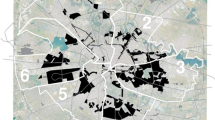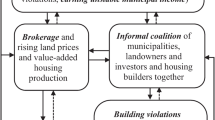Abstract
The dilapidation of building stock that has come to characterise the hillside and mountainous settlements of the region of Abruzzo in recent decades is a sign of forms of economic decline and negative demographic trends. In this situation, it is difficult to imagine occasions for a turn in events triggered by endogenous forces; instead, there is a sense of the need for public intervention and targeted economic-social policies. Indeed, in settlements lacking important resources for tourism and/or infrastructures for winter sports, it is very difficult to imagine their recovery through interventions entrusted solely to the market: often negligible property values suggest the inconvenience of any building requalification project in relation to asset or income-based objectives of valorisation. The reconstruction process put into place after the 2009 earthquake could have been interpreted and implemented within a vaster programme of interventions based on clear and defined strategic capable of guaranteeing prospects for the long-term relaunching and development of damaged areas. The initial idea behind the Reconstruction Plans appeared to confirm a similar approach. In reality, reconstruction is proceeding as a simple programme of building recovery. The paper develops this thesis by attempting to demonstrate how almost a decade after the 2009 earthquake, the funding provided to date has not produced particularly relevant effects on local economics and demographics.
Access this chapter
Tax calculation will be finalised at checkout
Purchases are for personal use only
Similar content being viewed by others
Notes
- 1.
Law 24 June 2009, n. 77, art.14, comma 5 bis.
- 2.
Decree issued by the Commissioner Delegated for the Reconstruction n.3 del 9.3.2010, art.5 comma 1.
- 3.
They represent approximately 18% of the comuni within the area of the earthquake crater.
- 4.
The USRA was instituted with Legislative Decree n. 83 in 2012, converted with modifications into Law n. 134 from 2012.
- 5.
The USRC, instituted with a Decree-Law in 2012, among its other responsibilities, monitors funding, implements interventions and manages the transmission of relative data to the Ministry of Economy and Finance.
- 6.
“The terms structural aggregate refers to a collection of buildings […] which are non-homogeneous, in contact with one another or with a connection, more or less efficacious, which may interact during an earthquake or similar dynamic. A structural aggregate can thus be comprised of a single building, or by multiple buildings with generally diverse structural characteristics. The presence of an efficient seismic joint is the basis for identifying two clearly distinct aggregates.” – Source. USRA Glossary.
- 7.
Source: www.tuttitalia.it, based on ISTAT data.
- 8.
The term resident population refers to the population comprised of people who habitually reside in the settlement begin studied – definition taken from “15th General Census of the Population and Inhabitations”, ISTAT October 2011.
- 9.
Small comuni are defined by Law 6 October 2017 n. 158, art. 1 comma 2.
- 10.
The demographic trend is expressed using the methodology adopted by ISTAT, in other words using the procedure reconstruction - population calculated between censuses of the resident population based both on Censuses made in 2001 and 2011 and by examining demographic movements (births, deaths, migrations) communicated by local governments to the statistics institute.
- 11.
Author's elaborations on National Institute of Statistics (ISTAT) data.
- 12.
Area: Central; Zone Code: B1; Typology: Civil residences; State of conservation: normal.
- 13.
Excluding the towns of Castelvecchio Subequo and Poggio Picenze for which the available data was insufficient.
- 14.
The average value of transactions inside the crater, over the course of twelve years, oscillates between a minimum of 0.8 for the town of Brittoli and 15.4 for the town of Popoli; the other 4 comuni do not exceed 4 transactions/year.
- 15.
Bicameral Committee for Belice, 2000 and Italian Chamber of Deputies, 2009.
References
Chen, H., Maki, N., Hayashi, H.: Disaster resilience and population ageing: the 1995 Kobe and 2004 Chuetsu earthquakes in Japan. Disasters 38(2), 291–309 (2014). https://doi.org/10.1111/disa.12048
Markhvida, M., Baker, J.W.: Unification of Seismic Performance Estimation and Real Estate Investment Analysis to Model Post-Earthquake Building Repair Decisions. Earthq. Spectra 34(4), 1787–1808 (2018). https://doi.org/10.1193/030118EQS048M
Di Giovanni, G.: Post-earthquake recovery in peripheral areas: The paradox of small municipalities’ reconstruction process in Abruzzo (Italy). Ital. J. Plan. Pract. 6(1), 110–139 (2016)
Monaco, F., Tortorella, W.: I Comuni della Strategia Nazionale Aree Interne. Prima edizione - 2015, IFEL Fondazione ANCI, 2015
Tramontana, C., Mallamace, S.: Patrimonio edilizio inutilizzato e valorizzazione dei centri storici: strumenti normativi e spunti procedurali. LaborEst 15(1), 5–12 (2017). https://doi.org/10.19254/LaborEst.15.01
Mollica, E., Massimo, D.E.: Valutazione degli strumenti del territorio e strumenti GIS. Aestimum 32, 710–757 (2002). https://doi.org/10.13128/aestimum-6782
Mollica, E.: La tematica economica nel recupero dei centri storici della Calabria. In: Book La tematica economica nel recupero dei centri storici della Calabria. Series La tematica economica nel recupero dei centri storici della Calabria 1, Editor ed.^eds., Gangemi, 1991, pp. 108–114
Garmaise, M.J., Moskowits, T.J.: Catastrophic risk and credit markets. J. Finance 64(2), 657–707 (2009). https://doi.org/10.1111/j.1540-6261.2009.01446.x
Finocchiaro, A.: Relazione sullo stato di avanzamento del processo di ricostruzione post-sismica nella regione Abruzzo (Aggiornata al 31 dicembre 2016), X.L. Senato della Repubblica (2017)
Carbonara, S.: La stima dei costi del patrimonio edilizio privato nella ricostruzione post-sismica abruzzese: un’analisi critica delle procedure utilizzate. Territorio 70, 119–125 (2014). https://doi.org/10.3280/tr2017-070019
Decaro, A: Agenda Controesodo, nuovi assetti e politiche per il sistema locale. In: Proc. XVII Conferenza Nazionale ANCI piccoli Comuni (2017)
Guerrieri, G.: Rapporto Immobiliare 2018. Osservatorio Mercato Immobiliare, Agenzia delle Entrate (2018)
Carbonara, S., Cerasa, D., Sclocco, T., Spacone, E.: A preliminary estimate of the rebuilding costs for the towns of the Abruzzo region affected by the April 2009 earthquake: An alternate approach to current legislative procedures. Computational Science and Its Applications - ICCSA 2015, vol. 9157, 2015, pp. 269–283; https://doi.org/10.1007/978-3-319-21470-2_19
Manganelli, B., Vona, M., Tataranna, S.: La piattaforma HBIM per la conservazione e la gestione sostenibile dei centri storici. LaborEst, vol. 19, no. 1 (2019)
Author information
Authors and Affiliations
Corresponding author
Editor information
Editors and Affiliations
Rights and permissions
Copyright information
© 2021 Springer Nature Switzerland AG
About this paper
Cite this paper
Carbonara, S., Stefano, D. (2021). Building Recovery, Property Values and Demographic Decline After the 2009 Abruzzo Earthquake. In: Bevilacqua, C., Calabrò, F., Della Spina, L. (eds) New Metropolitan Perspectives. NMP 2020. Smart Innovation, Systems and Technologies, vol 178. Springer, Cham. https://doi.org/10.1007/978-3-030-48279-4_73
Download citation
DOI: https://doi.org/10.1007/978-3-030-48279-4_73
Published:
Publisher Name: Springer, Cham
Print ISBN: 978-3-030-48278-7
Online ISBN: 978-3-030-48279-4
eBook Packages: Intelligent Technologies and RoboticsIntelligent Technologies and Robotics (R0)




